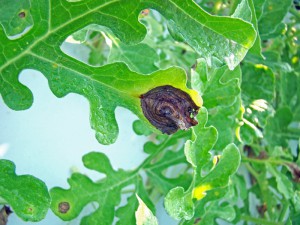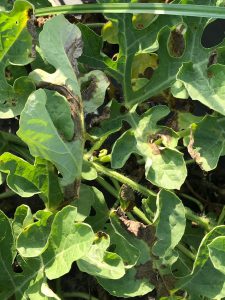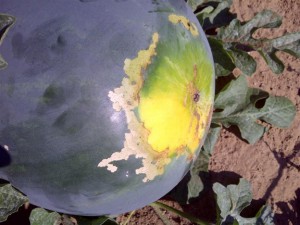Bob Hochmuth with input from Suwannee Valley Extension Agents: Mark Warren (Levy), Tyler Pittman (Gilchrist), Tatiana Sanchez (Alachua), Luke Harlow (Union), Jay Capasso (Columbia), Dan Fenneman (Madison), Keith Wynn (Hamilton), Danielle Sprague (Jefferson), Emily Beach (Lafayette), Amanda Phillips (Suwannee), Kevin Athearn (RSA-Agri- business), and Sudeep Sidhu (RSA- Water Resources).
Disease Update
The weather has been our greatest ally against disease over the past few weeks. We continue to report very good news in that we have simply not seen much disease activity of any concern, other than the increasing concerns over Fusarium wilt this spring. However, the multiple violent storms over the weekend could certainly change things in those fields where the storms hit. We have confirmed isolated cases of hail in other crops in the northern part of the Suwannee Valley as well. The increasing incidence of Fusarium in fields where the risk should be low is very alarming. The decrease in availability of land for suitable rotation makes this challenge even greater. Regarding spray programs once harvests start, pay close attention to pre-harvest intervals (PHI). Common rotations after harvests begin will include the following materials: Mancozeb (Manzate, Penncozeb) which has a PHI of 5 days, Quintec 3 day PHI, and Procure 0 day PHI. But, other materials like tebuconozole, Inspire Super, and Luna Experience all have a 7 day PHI, so be alert to the PHI and your harvesting schedule and food safety records.
The other great news is that we still do not have any confirmed cases of downy mildew in the Suwannee Valley, so hopefully we can totally avoid/minimize the expensive sprays for downy. We are still on alert and will let you know if we get any confirmed cases of downy. Until then, save your money on those sprays. (Bob Hochmuth)
–
Gummy Stem Blight
Even though we have not seen much disease activity up to this point, we are becoming more concerned about gummy stem blight. Most samples submitted over the past two weeks for foliar disease ID have come back with gummy stem blight as the main pathogen. The multiple rainstorms over the past several days could certainly set the stage for gummy stem blight to be more active and potentially a major concern if gummy stem blight is already present. Of course, not all fields even have gummy, so, make sure you know the situations in your fields. We also know we can move gummy stem blight spores on workers in the fields once we start harvests, especially if fields are wet.
We have some guidance to share if gummy stem blight is a concern in your fields. Research at Universities in the southeastern US, including UF/IFAS consistently rank Inspire Super in the top performer category for gummy stem blight, but it has a 7 day preharvest interval (PHI). So, if you have 7 days before your next harvest, Inspire Super is your #1 choice. However, if you have already sprayed Inspire Super or are at less than 7 days to next harvest, what should you use? In those cases, Aprovia Top would be a good option. Aprovia Top has performed very similarly to Inspire Super in most trials, and has a 0 day PHI on the label. The main caution is that both Inspire Super and Aprovia Top have FRAC group 3 fungicides in their ingredients, so we want to minimize the number of applications of these two in rotation. If gummy stem blight is not present in your fields, then mancozeb and tebuconazole is a good option at a lower cost than the other options above. Keep in mind Aprovia Top is a great option, if needed during the harvest season. (Bob Hochmuth and Mathews Paret).
–
Nutrient Management Update
Most conventionally fertilized fields are at the stage of growth where the fertigation rates likely should be 2,0- 2.5 lbs per acre per day rate for nitrogen and potassium, using the net acres of watermelons in the field (not including drive middles and other non-cropped areas in the field). Once we start harvests, it is common to set the rate at 2.0 lbs per acre per day and leave it there until one week from last pick. It is not useful to fertigate that last week of harvest. Once we get to first harvest, we typically stop using petiole-sap testing and set things at the 2.0 lbs/A/day rate. If you have situations where you think sap testing may be helpful, let us know. Otherwise, we will not be continuing that service as you approach or are into harvesting. (Bob Hochmuth)
–
Maintain Preventative Rindworm Sprays
A very economical program is to add a Bt (Bacillus thuringiensis) spray now and continue this weekly until pressure gets high. Bt is effective in killing young worms shortly after they hatch from feeding on the leaves. But, Bt is not a good choice for larger worms discovered later in their life cycle. Once pressure is high, you should switch to Coragen or Intrepid. This is the general program we have used very successfully here at the Center in Live Oak for several years. (Bob Hochmuth)
–
Join the Florida Watermelon Association
It is the mission of the Florida Watermelon Association to support research, education, and promotion of the fresh Florida watermelon industry. If you are not a current member, I encourage you to join. Your voice as a watermelon farmer needs to be heard on so many issues, now more than ever. All watermelon farmers and allied industry representatives should join. I am a member, and I encourage every reader of this weekly update to join as well. The 54th Annual FWA Convention will be November 1-3, 2022, in St. Petersburg, Florida. To join FWA or find out how to register for the 2022 Convention, go to https://www.flfwa.com/
- 2024 Watermelon Season Wrap Up - June 21, 2024
- Weekly Watermelon Update – June 3 - June 7, 2024
- Weekly Watermelon Update #10 – May 20 - May 24, 2024



